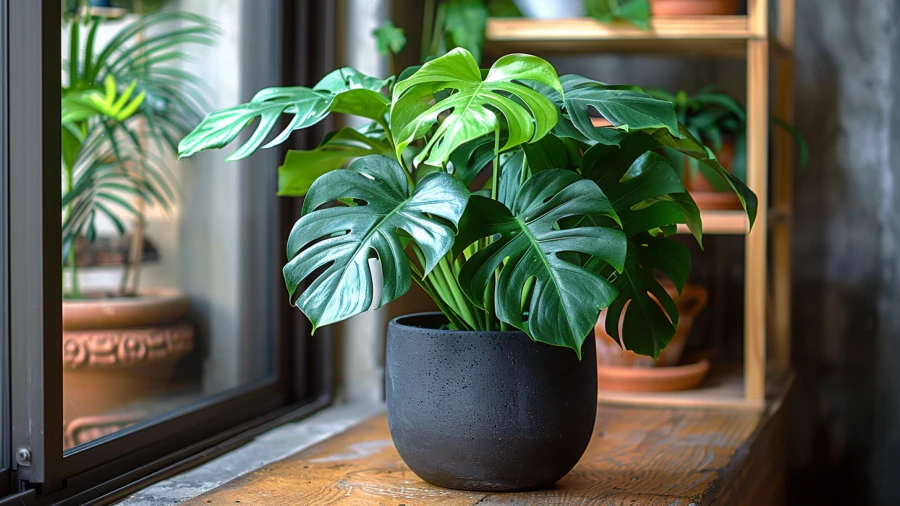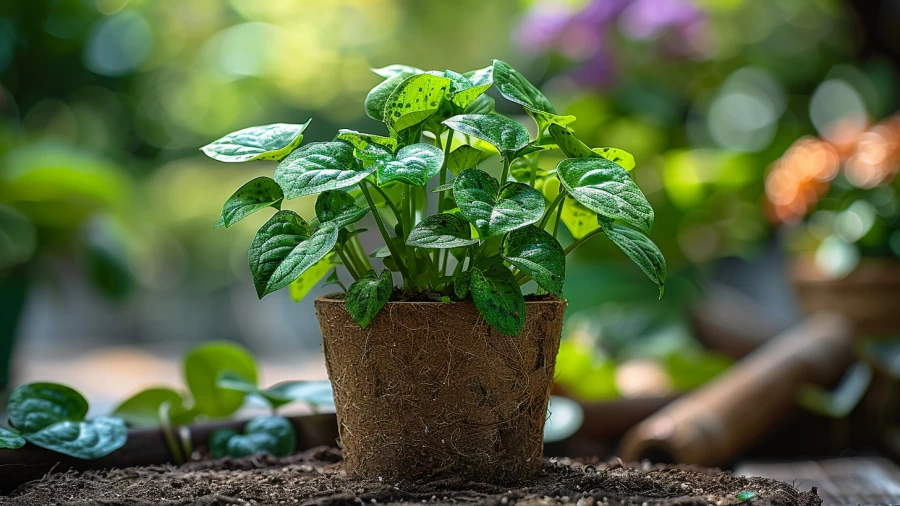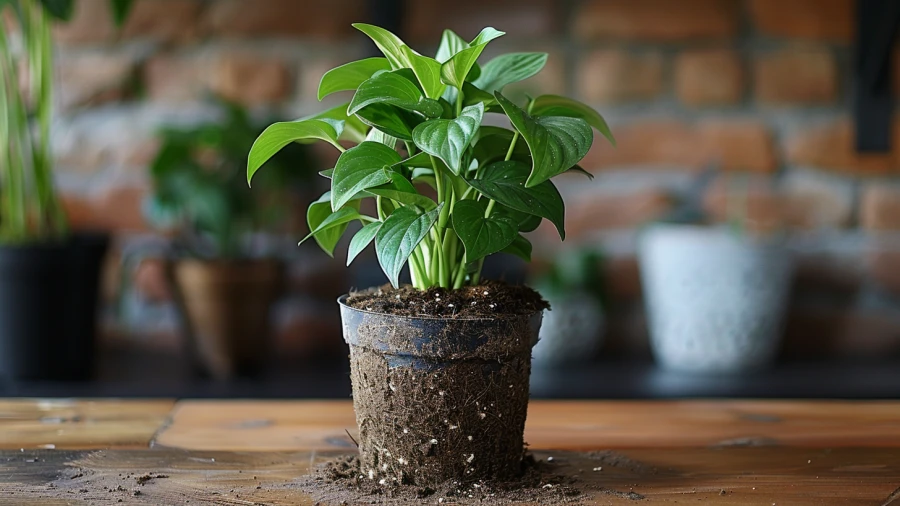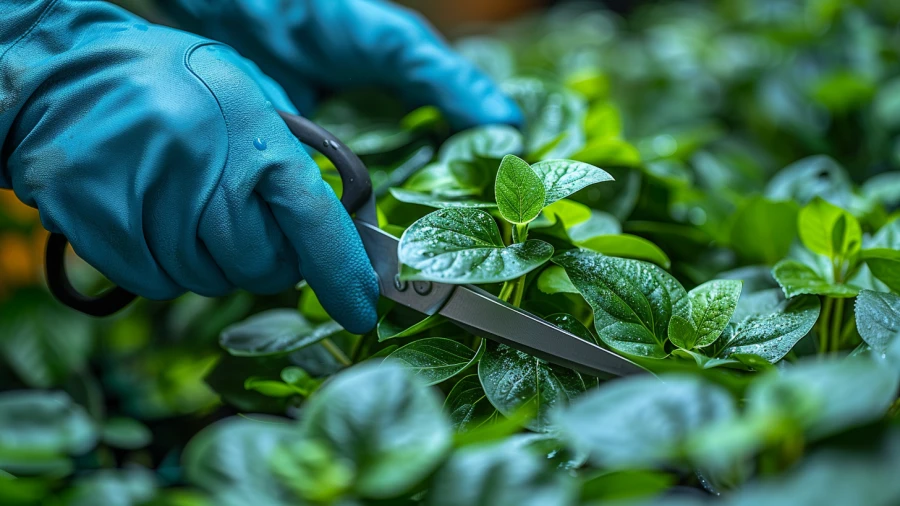
How to Propagate Swiss Cheese Plant with Easy Guide
Learn how to propagate a Swiss cheese plant (Monstera adansonii) easily from cuttings and this guide covers methods like water propagation and soil planting.
by Ruksana
Updated Oct 19, 2024
On This Page
- How to Propagate Swiss Cheese Plant?
- Propagating in Water.
- Propagating in Soil.
- Propagating With Air Layering.
- Why is my Swiss Cheese Plant turning yellow?
- Pests.
- Overwatering.
- Underwatering.
- Temperature Fluctuations.
- Sunburn.
- Pot-bound Roots.
- How to make Swiss Cheese Plant Bushy?
- Pruning.
- Providing Support.
- Optimal Light Conditions.
- Fertilizing.
- How to Care for a Swiss Cheese Plant?
- Light Requirements.
- Watering Schedule.
- Humidity Levels.
How to Propagate Swiss Cheese Plant?
To propagate a Swiss cheese plant (Monstera adansonii), you can use cuttings, which is the easiest method. First, take a stem cutting just below a healthy leaf node, making sure it has at least one leaf. Place the cutting in a glass of water, ensuring the cut end is submerged.
Propagating in Water:
To propagate a Swiss Cheese Plant in water, start by taking a cutting from the plant. Use clean scissors to cut a stem just below a leaf node, ensuring at least one leaf remains attached. Next, place the cutting in a clear glass of room temperature water, making sure the cut end is submerged. Position the container in a spot with bright, indirect sunlight. Change the water every few days to keep it fresh. In about two weeks, you should see roots forming. Once the roots are about two inches long, transplant the cutting into the soil for permanent growth.
Propagating in Soil:
For soil propagation, begin by cutting a healthy stem from the parent Swiss Cheese Plant, again ensuring there’s at least one leaf. Fill a small pot with moist potting soil, then insert the cutting into the soil, burying it up to the leaf node. Water the soil lightly to help settle the cutting. Place the pot in a location with indirect sunlight. Keep the soil consistently moist but not soggy. With proper care, roots will develop within a few weeks, and you’ll soon have a new plant growing in the soil.
Propagating With Air Layering:
Air layering is a more advanced method for propagating Swiss Cheese Plants. Start by selecting a healthy stem and make a small cut on the underside, about a third of the way through. Wrap the cut area with moist sphagnum moss and secure it with plastic wrap to hold moisture. After a few months, roots should begin to form in the moss. Once the roots are visible, cut below the new root system and transplant the rooted section into a pot with soil. This method encourages robust growth due to the established roots.
Why is my Swiss Cheese Plant turning yellow?
Pests:
If your Swiss Cheese Plant's leaves are turning yellow, pests could be the problem. Common pests include spider mites and aphids, which can cause stress to the plant. Check the undersides of leaves and stems for tiny insects or webs. If you find pests, act quickly by wiping them off with a damp cloth. For serious infestations, consider using insecticidal soap or a natural pesticide. Keeping the plant healthy and regularly inspecting it for pests will help prevent yellowing leaves and ensure your plant thrives.
Overwatering:
Overwatering is a common reason for yellowing leaves on a Swiss Cheese Plant. When the plant receives too much water, its roots can rot, leading to nutrient absorption issues. If you notice yellow leaves, check the soil moisture. If it feels soggy, hold off on watering until the top inch dries out. Adjust your watering schedule to allow the soil to dry slightly between waterings, ensuring your plant stays healthy and happy. This simple change can prevent yellowing leaves and encourage new growth.
Underwatering:
Underwatering can also lead to yellow leaves on your Swiss Cheese Plant. When the plant does not get enough water, it struggles to absorb nutrients, causing its leaves to yellow or become crispy. To fix this, check the soil regularly. If it feels dry several inches down, give your plant a thorough watering, allowing excess water to drain. Over time, you’ll notice improvement in the leaf color as the plant rehydrates. Establishing a consistent watering routine will help prevent underwatering and keep your plant vibrant.
Temperature Fluctuations:
Swiss Cheese Plants prefer stable temperatures between 65°F and 85°F. If your plant experiences sudden temperature changes, it may respond by yellowing its leaves. Common causes include moving the plant near drafty windows or heat sources. To fix this, find a location that offers consistent warmth away from cold drafts or heat vents. If the air in your home is too dry, consider misting the leaves or using a humidifier. Keeping the plant in a stable environment will help prevent yellowing and promote healthy growth.
Sunburn:
Sunburn can also cause yellow leaves on your Swiss Cheese Plant. If your plant is exposed to direct sunlight for long periods, its leaves may get scorched, turning yellow or brown at the edges. To help your plant recover, move it to a spot with bright, indirect light. This will allow it to receive enough sunlight without the risk of burning. Adjusting its location to prevent sunburn is crucial for maintaining healthy, vibrant leaves on your Swiss Cheese Plant.
Pot-bound Roots:
Pot-bound roots occur when a plant's roots outgrow their container, leading to yellow leaves due to nutrient deficiencies. If you see roots growing out of the drainage holes or circling the bottom of the pot, it's time to repot your Swiss Cheese Plant. Choose a pot that is one size larger and fill it with fresh potting soil. This will give the roots room to grow and access new nutrients, helping to restore the plant’s health and prevent yellowing leaves.
How to make Swiss Cheese Plant Bushy?
Pruning:
Pruning is a vital method for making your Swiss Cheese Plant bushy. By trimming back long or leggy stems, you encourage the growth of new branches and leaves. Use clean scissors to snip off the top inch or so of the stem, just above a leaf node. This encourages lateral growth and helps the plant fill out. Regular pruning every few months will keep your plant looking full and healthy. By maintaining its shape, you promote bushier growth, enhancing the overall appearance of your Swiss Cheese Plant.
Providing Support:
Providing support for your Swiss Cheese Plant can also promote bushier growth. These plants naturally climb, so using a moss pole or trellis helps encourage upward growth and fuller foliage. As the plant climbs, it will develop more branches and leaves, creating a lush appearance. Insert the support into the pot, making sure it is sturdy. Gently tie the stems to the support with soft plant ties. This method allows your Swiss Cheese Plant to thrive and look fuller as it grows.
Optimal Light Conditions:
To achieve a bushier Swiss Cheese Plant, ensure it gets optimal light conditions. These plants thrive in bright, indirect sunlight. If the light is too low, they may grow leggy and sparse as they reach for light. Place your plant near a window where it can receive filtered sunlight, avoiding direct sun, which can scorch the leaves. With the right lighting, your Swiss Cheese Plant will become fuller and bushier, with vibrant leaves and a healthy appearance.
Fertilizing:
Regular fertilization can help promote bushy growth in your Swiss Cheese Plant. During the growing season (spring and summer), use a balanced, diluted liquid fertilizer every month. This provides essential nutrients that encourage healthy leaf and stem development. Avoid fertilizing in winter, as the plant’s growth slows down. With proper fertilization, your Swiss Cheese Plant will produce more foliage, contributing to a fuller, bushier appearance.
How to Care for a Swiss Cheese Plant?
Light Requirements:
To care for a Swiss Cheese Plant, provide it with the right light conditions. These plants thrive in bright, indirect sunlight. Avoid placing them in direct sunlight, as this can scorch the leaves. A location near a window with filtered light is ideal. If your plant isn’t getting enough light, it may become leggy as it stretches towards the light source. Adjusting its position to ensure it receives the right amount of light will help keep your Swiss Cheese Plant healthy and vibrant.
Watering Schedule:
Watering is crucial for your Swiss Cheese Plant’s health. Allow the top inch of soil to dry out between waterings, as these plants prefer slightly dry conditions. Overwatering can lead to root rot, while underwatering can cause yellow leaves. When you water, do so thoroughly until excess water drains out of the pot. This ensures that the roots receive enough moisture without sitting in soggy soil. Establishing a consistent watering schedule will keep your plant happy and thriving.
Humidity Levels:
Swiss Cheese Plants love humidity and thrive in moist environments. If your home is dry, consider misting the leaves regularly or placing a humidifier nearby. This helps maintain the humidity levels that these tropical plants prefer. You can also place the pot on a tray filled with pebbles and water to increase humidity around the plant. Keeping your Swiss Cheese Plant in a humid environment will encourage healthy growth and vibrant foliage.























